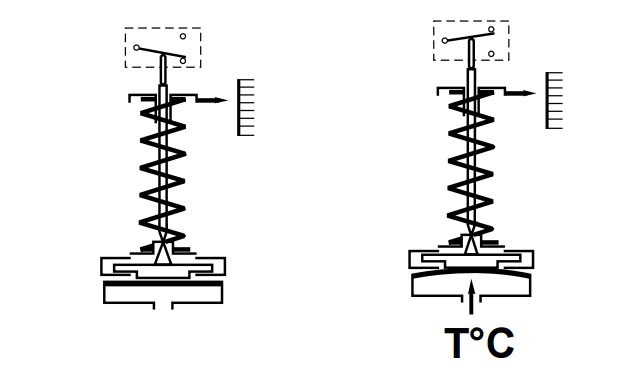Temperature Switch has a vapour filled flexible sensing element actuates a micro switch by means of a piston when temperature reaches the setpoint. The set point is adjusted by means of a compressible spring or a adjustable screw installed in the switch.

The temperature switch consists of a pressure switch that has a sealed temperature sensing bulb attached directly to the pressure port. (An optional remote temperature sensing bulb can be connected to the pressure port with an armor-clad capillary.) The temperature sensing system is partially filled with a fluid.
Process temperature changes cause proportional vapor pressure changes in the temperature sensing bulb that act on the diaphragm/piston assembly to actuate and de-actuates a snap-action electrical switching element at discrete process temperatures. The change in electrical contact indicates the required temperature value.
A bi-stable electromechanical device that actuates/ deactuates one or more electrical switching element(s) at a predetermined discrete temperature (set point) upon rising or falling temperature.
The span of temperature between upper and lower limits within which the temperature switch can be adjusted to actuate/deactuate. It is expressed for increasing temperature.
That discrete temperature at which the temperature switch is adjusted to actuate/deactuate on rising or falling temperature. It must fall within the adjustable range and be called out as increasing or decreasing temperature.
The difference in temperature between the increasing set point and decreasing set point. It is expressed as “typical,” which is an average with the increasing set point at mid-adjustable range with the standard K switch element. It is normally fixed (not adjustable).
A welded steel capsule with glass-to-metal, factory sealed electrical leads that isolates the electrical switching element(s) from the environment.
Over-range temperature is that temperature to which the sensing bulb can be continuously exposed without causing permanent change of set point or distortion sufficient to cause leakage or significant degradation of the fill fluid. Temperatures greater than over-range could cause permanent damage and render the device inoperative.
The maximum process pressure to which the temperature sensing bulb should be exposed without being protected by a thermowell.
The ability of a temperature switch to successively operate at a set point that is approached from a starting point in the same direction and returns to the starting point over consecutive cycles to establish a temperature profile. The closeness of the measured set point values is normally expressed as percentage of full scale (maximum adjustable range temperature.)
Single-Pole, Double-Throw (SPDT) has three connections: C-Common, NO-Normally Open and NC-Normally Closed, which allows the switch to be electrically connected to the circuit in either NO or NC state.
DPDT is two synchronized SPDT switching elements which actuate together at increasing set point and deactuate together at decreasing set point. Discrete SPDT switching elements allow two independent circuits to be switched; i.e., one AC and one DC. The synchronization linkage is factory set, and is not field adjustable.
Synchronization is verified by connecting test lamps to the switching elements and observing them go “On” simultaneously at actuation and “Off” simultaneously at deactuation.
Standard factory adjustment Setpoint at 50% of the scale on falling temperature. ( it may change as per vendor)
The following specifications to be checked in a temperature switch:
Determine if direct or remote (and capillary length) sensing is required. Select temperature Sensing Bulb Designator from specifications.
Determine the adjustable range required. Select Temperature Switch range as per requirement.
Select Housing for type of service.
Select Switching Element for housing and electrical service.
Select Diaphragm System.
Select Accessories as required for service.
Determine if Thermowell is required or not.
Source : Baumer
In this article, you will learn the STAR DELTA programming using PLC controller to start…
Lube oil consoles of rotary equipment packages in industrial process plants are usually equipped with…
Rotating equipment packages such as pumps, compressors, turbines need the lube oil consoles for their…
This article explains how to blink lights in ladder logic with a detailed explanation video…
In this article, a simple example will teach you the conversion from Boolean algebra to…
In this article, you will learn the PLC cooking timer example for kitchen automation using…